Experiential Learning, Community Engagement, and Education
VerifiedAdded on 2023/06/10
|10
|2651
|220
Essay
AI Summary
This essay delves into the crucial role of experiential learning within communities, emphasizing the significance of community engagement, intercultural communication, and inclusive language. It highlights the importance of effective communication skills in sharing information and fostering understanding among diverse community members. The essay explores how experiential learning facilitates knowledge transfer across generations and promotes ethical, interactive relationships. It also examines intercultural communication models, such as Hofstede's culture-specific and culture-general approaches, to enhance communication skills in diverse settings. Furthermore, the essay discusses the management of community engagement through communication, including preparation, reflection, and dialogue. It emphasizes the need for inclusive language and education to foster mutual respect and unity within communities, particularly in the context of Australian society and its indigenous populations. The essay concludes by underscoring the positive impact of experiential learning on developing interaction skills, increasing knowledge transfer, and shaping cognitive abilities, especially in educational settings like schools, which play a vital role in shaping perceptions and abilities.
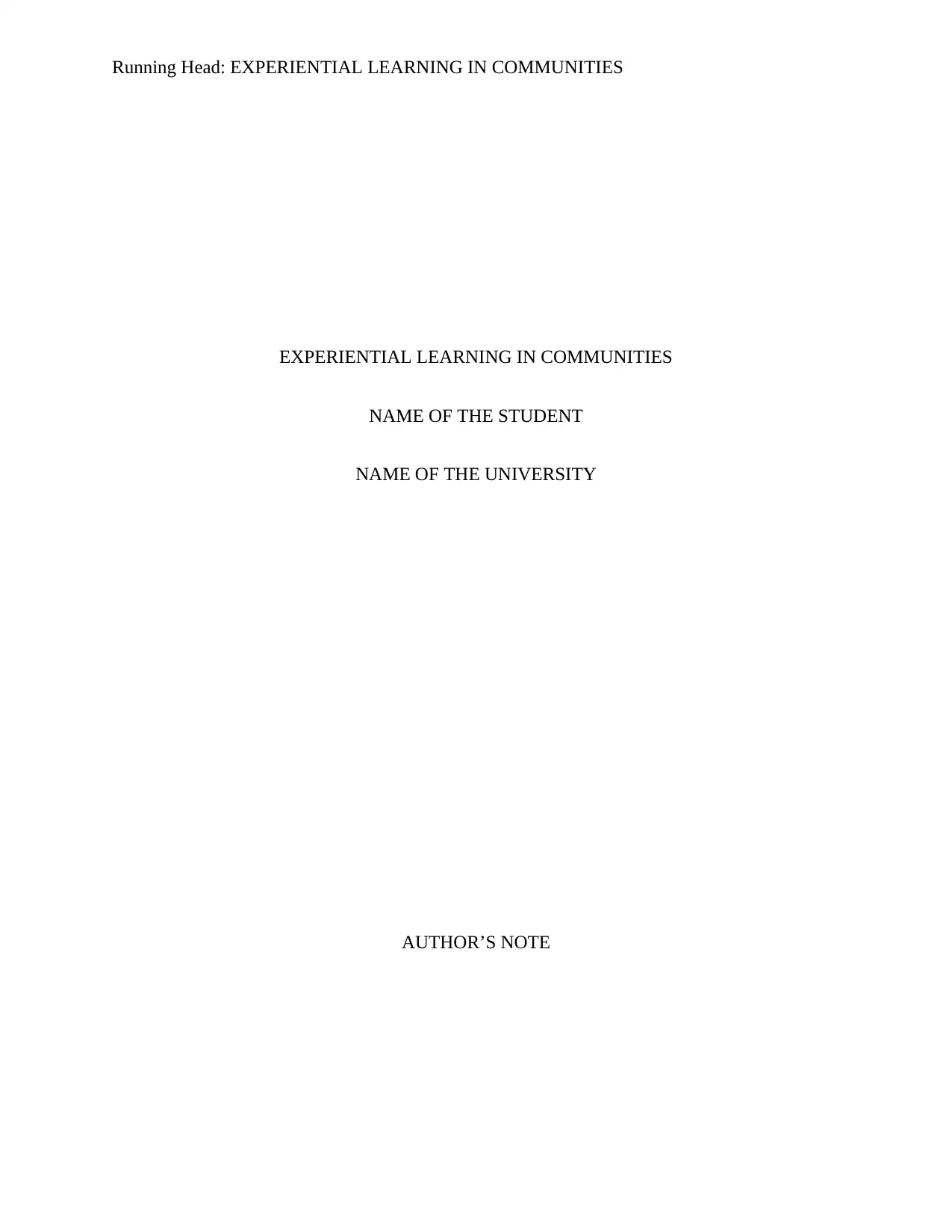
Running Head: EXPERIENTIAL LEARNING IN COMMUNITIES
EXPERIENTIAL LEARNING IN COMMUNITIES
NAME OF THE STUDENT
NAME OF THE UNIVERSITY
AUTHOR’S NOTE
EXPERIENTIAL LEARNING IN COMMUNITIES
NAME OF THE STUDENT
NAME OF THE UNIVERSITY
AUTHOR’S NOTE
Paraphrase This Document
Need a fresh take? Get an instant paraphrase of this document with our AI Paraphraser
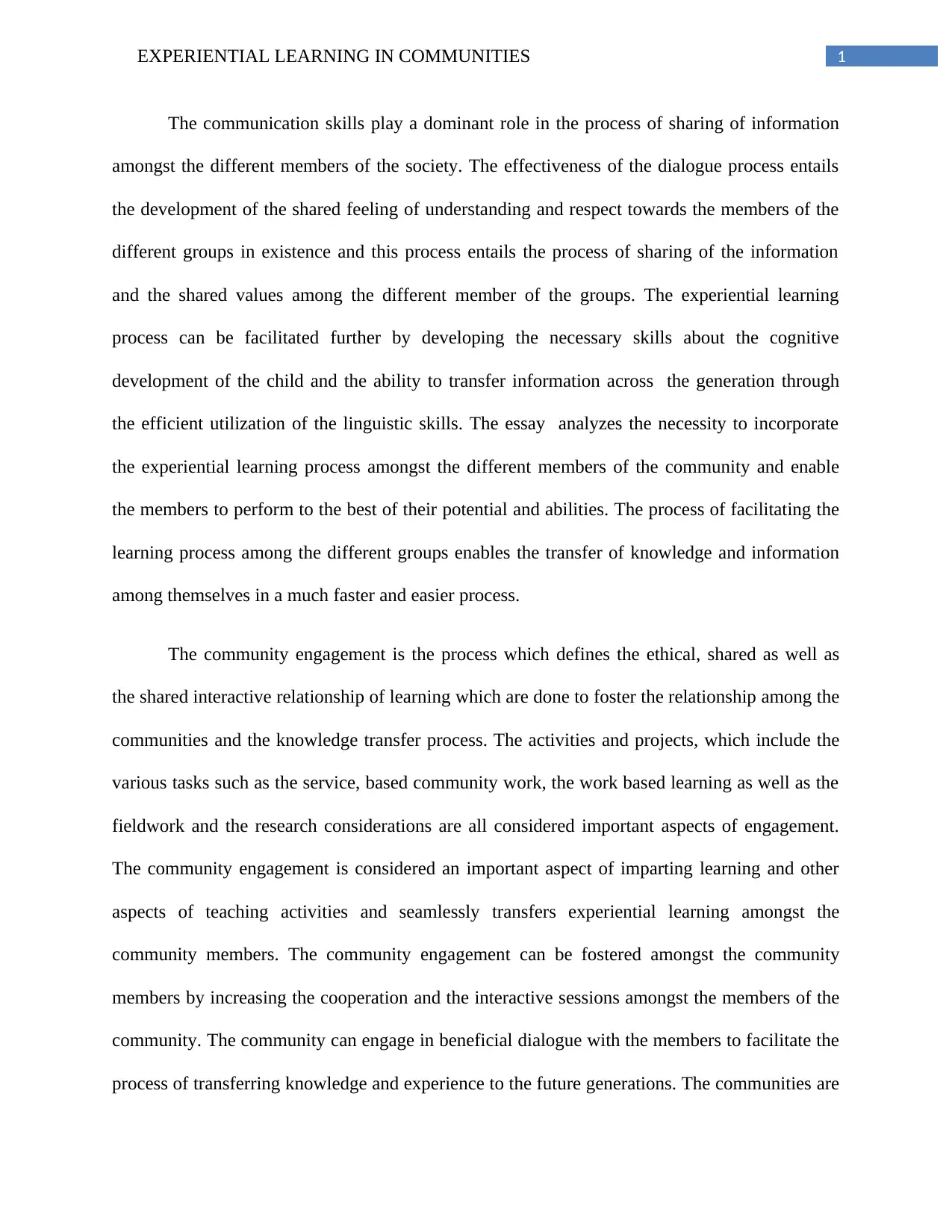
1EXPERIENTIAL LEARNING IN COMMUNITIES
The communication skills play a dominant role in the process of sharing of information
amongst the different members of the society. The effectiveness of the dialogue process entails
the development of the shared feeling of understanding and respect towards the members of the
different groups in existence and this process entails the process of sharing of the information
and the shared values among the different member of the groups. The experiential learning
process can be facilitated further by developing the necessary skills about the cognitive
development of the child and the ability to transfer information across the generation through
the efficient utilization of the linguistic skills. The essay analyzes the necessity to incorporate
the experiential learning process amongst the different members of the community and enable
the members to perform to the best of their potential and abilities. The process of facilitating the
learning process among the different groups enables the transfer of knowledge and information
among themselves in a much faster and easier process.
The community engagement is the process which defines the ethical, shared as well as
the shared interactive relationship of learning which are done to foster the relationship among the
communities and the knowledge transfer process. The activities and projects, which include the
various tasks such as the service, based community work, the work based learning as well as the
fieldwork and the research considerations are all considered important aspects of engagement.
The community engagement is considered an important aspect of imparting learning and other
aspects of teaching activities and seamlessly transfers experiential learning amongst the
community members. The community engagement can be fostered amongst the community
members by increasing the cooperation and the interactive sessions amongst the members of the
community. The community can engage in beneficial dialogue with the members to facilitate the
process of transferring knowledge and experience to the future generations. The communities are
The communication skills play a dominant role in the process of sharing of information
amongst the different members of the society. The effectiveness of the dialogue process entails
the development of the shared feeling of understanding and respect towards the members of the
different groups in existence and this process entails the process of sharing of the information
and the shared values among the different member of the groups. The experiential learning
process can be facilitated further by developing the necessary skills about the cognitive
development of the child and the ability to transfer information across the generation through
the efficient utilization of the linguistic skills. The essay analyzes the necessity to incorporate
the experiential learning process amongst the different members of the community and enable
the members to perform to the best of their potential and abilities. The process of facilitating the
learning process among the different groups enables the transfer of knowledge and information
among themselves in a much faster and easier process.
The community engagement is the process which defines the ethical, shared as well as
the shared interactive relationship of learning which are done to foster the relationship among the
communities and the knowledge transfer process. The activities and projects, which include the
various tasks such as the service, based community work, the work based learning as well as the
fieldwork and the research considerations are all considered important aspects of engagement.
The community engagement is considered an important aspect of imparting learning and other
aspects of teaching activities and seamlessly transfers experiential learning amongst the
community members. The community engagement can be fostered amongst the community
members by increasing the cooperation and the interactive sessions amongst the members of the
community. The community can engage in beneficial dialogue with the members to facilitate the
process of transferring knowledge and experience to the future generations. The communities are
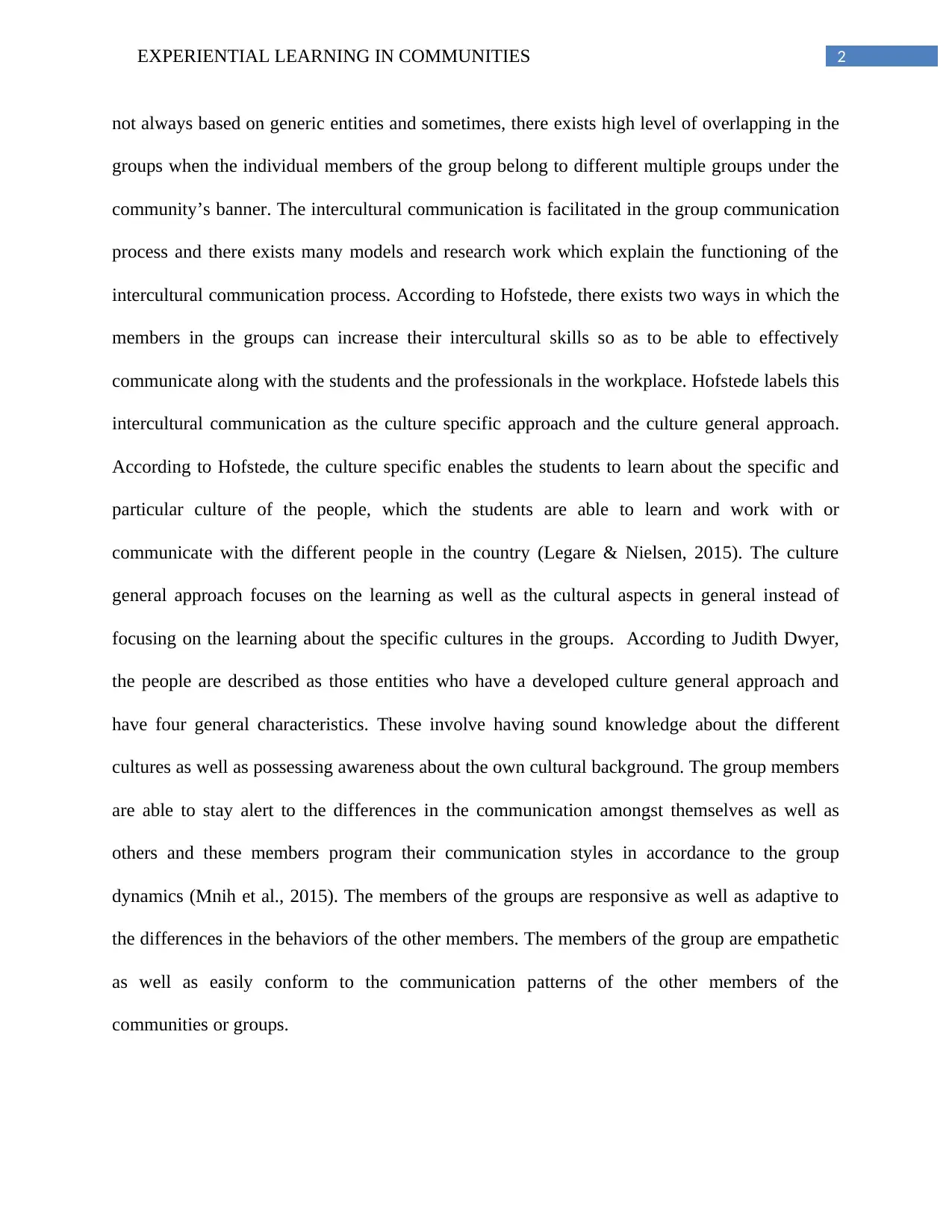
2EXPERIENTIAL LEARNING IN COMMUNITIES
not always based on generic entities and sometimes, there exists high level of overlapping in the
groups when the individual members of the group belong to different multiple groups under the
community’s banner. The intercultural communication is facilitated in the group communication
process and there exists many models and research work which explain the functioning of the
intercultural communication process. According to Hofstede, there exists two ways in which the
members in the groups can increase their intercultural skills so as to be able to effectively
communicate along with the students and the professionals in the workplace. Hofstede labels this
intercultural communication as the culture specific approach and the culture general approach.
According to Hofstede, the culture specific enables the students to learn about the specific and
particular culture of the people, which the students are able to learn and work with or
communicate with the different people in the country (Legare & Nielsen, 2015). The culture
general approach focuses on the learning as well as the cultural aspects in general instead of
focusing on the learning about the specific cultures in the groups. According to Judith Dwyer,
the people are described as those entities who have a developed culture general approach and
have four general characteristics. These involve having sound knowledge about the different
cultures as well as possessing awareness about the own cultural background. The group members
are able to stay alert to the differences in the communication amongst themselves as well as
others and these members program their communication styles in accordance to the group
dynamics (Mnih et al., 2015). The members of the groups are responsive as well as adaptive to
the differences in the behaviors of the other members. The members of the group are empathetic
as well as easily conform to the communication patterns of the other members of the
communities or groups.
not always based on generic entities and sometimes, there exists high level of overlapping in the
groups when the individual members of the group belong to different multiple groups under the
community’s banner. The intercultural communication is facilitated in the group communication
process and there exists many models and research work which explain the functioning of the
intercultural communication process. According to Hofstede, there exists two ways in which the
members in the groups can increase their intercultural skills so as to be able to effectively
communicate along with the students and the professionals in the workplace. Hofstede labels this
intercultural communication as the culture specific approach and the culture general approach.
According to Hofstede, the culture specific enables the students to learn about the specific and
particular culture of the people, which the students are able to learn and work with or
communicate with the different people in the country (Legare & Nielsen, 2015). The culture
general approach focuses on the learning as well as the cultural aspects in general instead of
focusing on the learning about the specific cultures in the groups. According to Judith Dwyer,
the people are described as those entities who have a developed culture general approach and
have four general characteristics. These involve having sound knowledge about the different
cultures as well as possessing awareness about the own cultural background. The group members
are able to stay alert to the differences in the communication amongst themselves as well as
others and these members program their communication styles in accordance to the group
dynamics (Mnih et al., 2015). The members of the groups are responsive as well as adaptive to
the differences in the behaviors of the other members. The members of the group are empathetic
as well as easily conform to the communication patterns of the other members of the
communities or groups.
⊘ This is a preview!⊘
Do you want full access?
Subscribe today to unlock all pages.

Trusted by 1+ million students worldwide
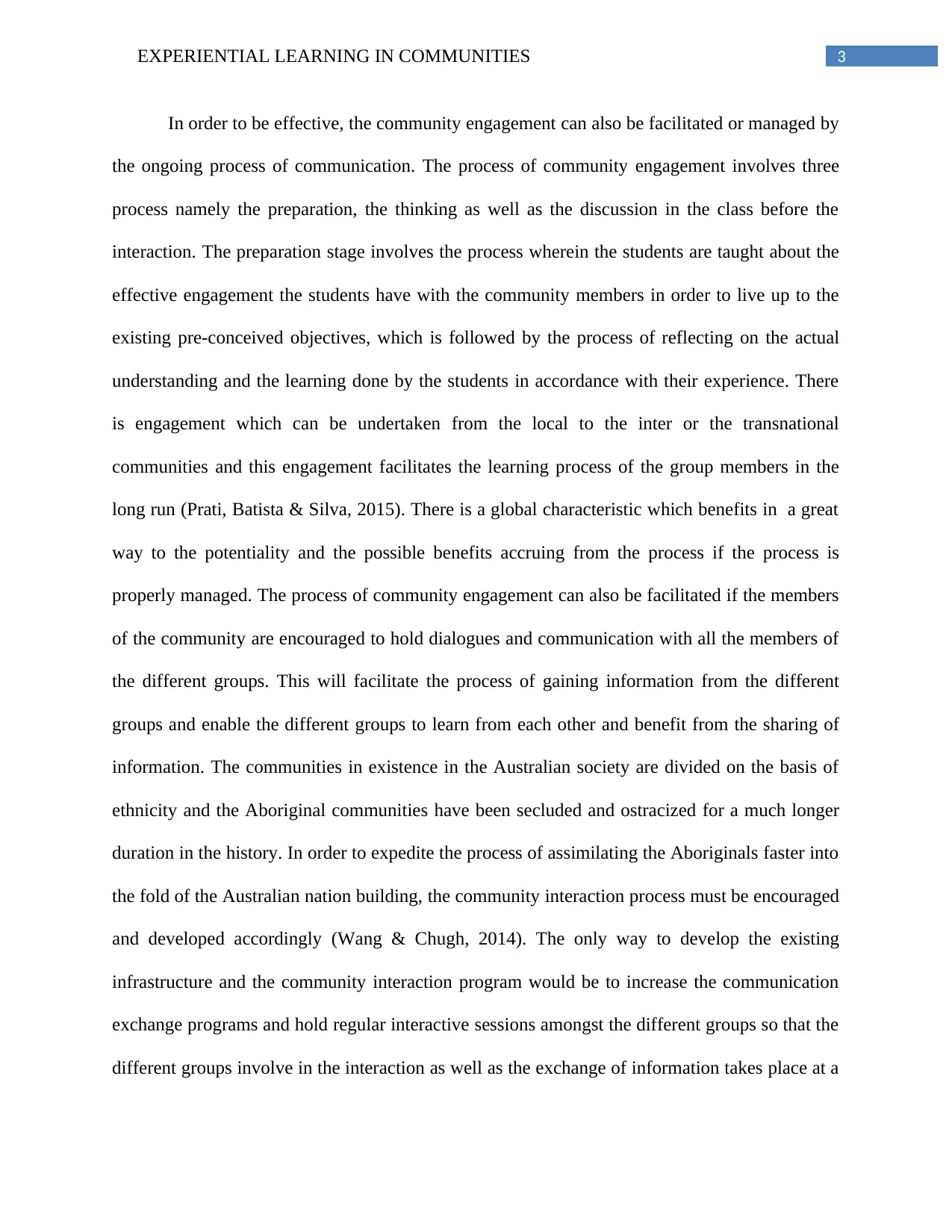
3EXPERIENTIAL LEARNING IN COMMUNITIES
In order to be effective, the community engagement can also be facilitated or managed by
the ongoing process of communication. The process of community engagement involves three
process namely the preparation, the thinking as well as the discussion in the class before the
interaction. The preparation stage involves the process wherein the students are taught about the
effective engagement the students have with the community members in order to live up to the
existing pre-conceived objectives, which is followed by the process of reflecting on the actual
understanding and the learning done by the students in accordance with their experience. There
is engagement which can be undertaken from the local to the inter or the transnational
communities and this engagement facilitates the learning process of the group members in the
long run (Prati, Batista & Silva, 2015). There is a global characteristic which benefits in a great
way to the potentiality and the possible benefits accruing from the process if the process is
properly managed. The process of community engagement can also be facilitated if the members
of the community are encouraged to hold dialogues and communication with all the members of
the different groups. This will facilitate the process of gaining information from the different
groups and enable the different groups to learn from each other and benefit from the sharing of
information. The communities in existence in the Australian society are divided on the basis of
ethnicity and the Aboriginal communities have been secluded and ostracized for a much longer
duration in the history. In order to expedite the process of assimilating the Aboriginals faster into
the fold of the Australian nation building, the community interaction process must be encouraged
and developed accordingly (Wang & Chugh, 2014). The only way to develop the existing
infrastructure and the community interaction program would be to increase the communication
exchange programs and hold regular interactive sessions amongst the different groups so that the
different groups involve in the interaction as well as the exchange of information takes place at a
In order to be effective, the community engagement can also be facilitated or managed by
the ongoing process of communication. The process of community engagement involves three
process namely the preparation, the thinking as well as the discussion in the class before the
interaction. The preparation stage involves the process wherein the students are taught about the
effective engagement the students have with the community members in order to live up to the
existing pre-conceived objectives, which is followed by the process of reflecting on the actual
understanding and the learning done by the students in accordance with their experience. There
is engagement which can be undertaken from the local to the inter or the transnational
communities and this engagement facilitates the learning process of the group members in the
long run (Prati, Batista & Silva, 2015). There is a global characteristic which benefits in a great
way to the potentiality and the possible benefits accruing from the process if the process is
properly managed. The process of community engagement can also be facilitated if the members
of the community are encouraged to hold dialogues and communication with all the members of
the different groups. This will facilitate the process of gaining information from the different
groups and enable the different groups to learn from each other and benefit from the sharing of
information. The communities in existence in the Australian society are divided on the basis of
ethnicity and the Aboriginal communities have been secluded and ostracized for a much longer
duration in the history. In order to expedite the process of assimilating the Aboriginals faster into
the fold of the Australian nation building, the community interaction process must be encouraged
and developed accordingly (Wang & Chugh, 2014). The only way to develop the existing
infrastructure and the community interaction program would be to increase the communication
exchange programs and hold regular interactive sessions amongst the different groups so that the
different groups involve in the interaction as well as the exchange of information takes place at a
Paraphrase This Document
Need a fresh take? Get an instant paraphrase of this document with our AI Paraphraser

4EXPERIENTIAL LEARNING IN COMMUNITIES
rapid pace. The management of the community interaction program enables the people to
communicate in a much better position and ability as compared to the previous condition
(Cornier & Hagman, 2014). The communities working in harmony in the exchange program
must be able to interact amongst themselves in a very friendly and composed manner and there
must be never any issue regarding their usage and the viability of the option regarding their
usage and framework.
The benefits of community engagement includes the development of the interaction and
the exchange of information among the members of the community who are in constant
interaction with each other. The process of community engagement includes the ability to
communicate effectively and in a much better way as compared to the informal interaction which
exists among the members of the different groups and organizations. The reflection of the
members of the group can increase the benefits accruing from the cognitive abilities which
includes the application of the experiential learning methods. The effective usage of the
community engagement process includes the principle of using the learning methods in
conjunction with the interaction processes, which enables the students to perform to the best of
their potential. The community engagement process has the capacity and the ability to assist the
developmental and the interpersonal skills which when used along with the academic learning
process helps increase the motivation of the students (Drachsler et al., 2015). The engagement
also adds to the sense of the test of the reality such as the students are able to engage in the
community and the students get exposure to the unique issues and the problems which presents a
richer learning experience. There is a greater level of understanding and trust among the
members of the community when they are able to engage in a meaningful and positive dialogue
process with the other members of the community. This process of engaging in positive dialogue
rapid pace. The management of the community interaction program enables the people to
communicate in a much better position and ability as compared to the previous condition
(Cornier & Hagman, 2014). The communities working in harmony in the exchange program
must be able to interact amongst themselves in a very friendly and composed manner and there
must be never any issue regarding their usage and the viability of the option regarding their
usage and framework.
The benefits of community engagement includes the development of the interaction and
the exchange of information among the members of the community who are in constant
interaction with each other. The process of community engagement includes the ability to
communicate effectively and in a much better way as compared to the informal interaction which
exists among the members of the different groups and organizations. The reflection of the
members of the group can increase the benefits accruing from the cognitive abilities which
includes the application of the experiential learning methods. The effective usage of the
community engagement process includes the principle of using the learning methods in
conjunction with the interaction processes, which enables the students to perform to the best of
their potential. The community engagement process has the capacity and the ability to assist the
developmental and the interpersonal skills which when used along with the academic learning
process helps increase the motivation of the students (Drachsler et al., 2015). The engagement
also adds to the sense of the test of the reality such as the students are able to engage in the
community and the students get exposure to the unique issues and the problems which presents a
richer learning experience. There is a greater level of understanding and trust among the
members of the community when they are able to engage in a meaningful and positive dialogue
process with the other members of the community. This process of engaging in positive dialogue
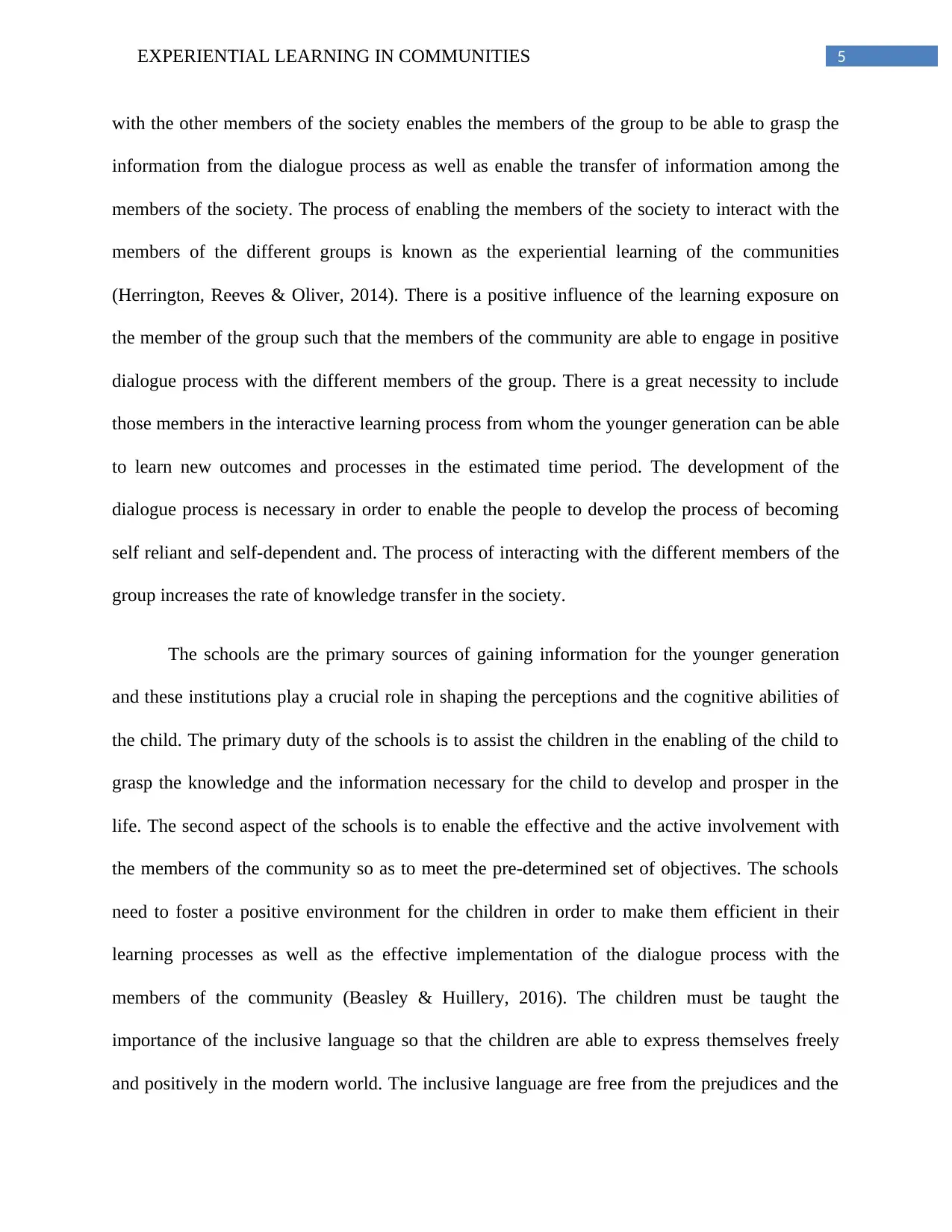
5EXPERIENTIAL LEARNING IN COMMUNITIES
with the other members of the society enables the members of the group to be able to grasp the
information from the dialogue process as well as enable the transfer of information among the
members of the society. The process of enabling the members of the society to interact with the
members of the different groups is known as the experiential learning of the communities
(Herrington, Reeves & Oliver, 2014). There is a positive influence of the learning exposure on
the member of the group such that the members of the community are able to engage in positive
dialogue process with the different members of the group. There is a great necessity to include
those members in the interactive learning process from whom the younger generation can be able
to learn new outcomes and processes in the estimated time period. The development of the
dialogue process is necessary in order to enable the people to develop the process of becoming
self reliant and self-dependent and. The process of interacting with the different members of the
group increases the rate of knowledge transfer in the society.
The schools are the primary sources of gaining information for the younger generation
and these institutions play a crucial role in shaping the perceptions and the cognitive abilities of
the child. The primary duty of the schools is to assist the children in the enabling of the child to
grasp the knowledge and the information necessary for the child to develop and prosper in the
life. The second aspect of the schools is to enable the effective and the active involvement with
the members of the community so as to meet the pre-determined set of objectives. The schools
need to foster a positive environment for the children in order to make them efficient in their
learning processes as well as the effective implementation of the dialogue process with the
members of the community (Beasley & Huillery, 2016). The children must be taught the
importance of the inclusive language so that the children are able to express themselves freely
and positively in the modern world. The inclusive language are free from the prejudices and the
with the other members of the society enables the members of the group to be able to grasp the
information from the dialogue process as well as enable the transfer of information among the
members of the society. The process of enabling the members of the society to interact with the
members of the different groups is known as the experiential learning of the communities
(Herrington, Reeves & Oliver, 2014). There is a positive influence of the learning exposure on
the member of the group such that the members of the community are able to engage in positive
dialogue process with the different members of the group. There is a great necessity to include
those members in the interactive learning process from whom the younger generation can be able
to learn new outcomes and processes in the estimated time period. The development of the
dialogue process is necessary in order to enable the people to develop the process of becoming
self reliant and self-dependent and. The process of interacting with the different members of the
group increases the rate of knowledge transfer in the society.
The schools are the primary sources of gaining information for the younger generation
and these institutions play a crucial role in shaping the perceptions and the cognitive abilities of
the child. The primary duty of the schools is to assist the children in the enabling of the child to
grasp the knowledge and the information necessary for the child to develop and prosper in the
life. The second aspect of the schools is to enable the effective and the active involvement with
the members of the community so as to meet the pre-determined set of objectives. The schools
need to foster a positive environment for the children in order to make them efficient in their
learning processes as well as the effective implementation of the dialogue process with the
members of the community (Beasley & Huillery, 2016). The children must be taught the
importance of the inclusive language so that the children are able to express themselves freely
and positively in the modern world. The inclusive language are free from the prejudices and the
⊘ This is a preview!⊘
Do you want full access?
Subscribe today to unlock all pages.

Trusted by 1+ million students worldwide
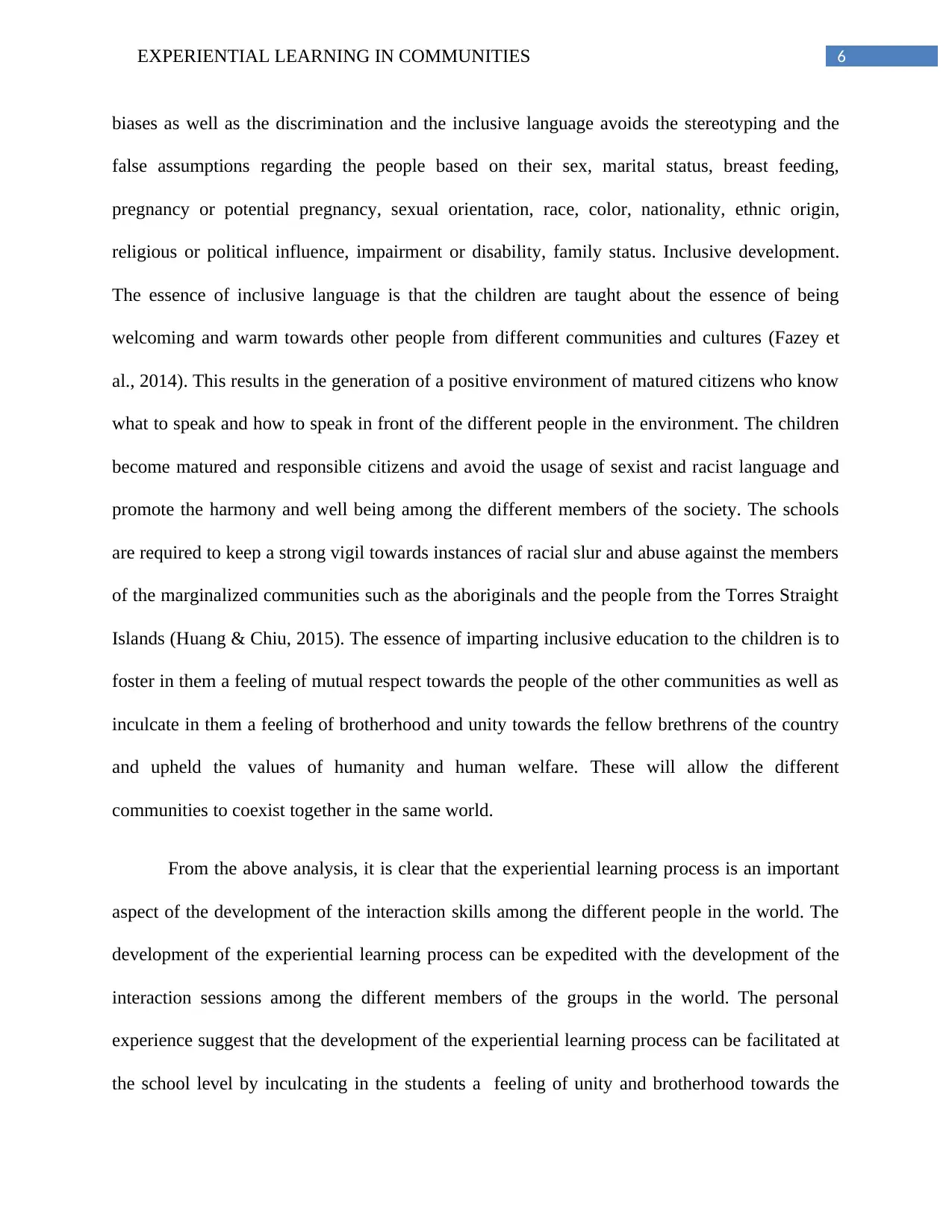
6EXPERIENTIAL LEARNING IN COMMUNITIES
biases as well as the discrimination and the inclusive language avoids the stereotyping and the
false assumptions regarding the people based on their sex, marital status, breast feeding,
pregnancy or potential pregnancy, sexual orientation, race, color, nationality, ethnic origin,
religious or political influence, impairment or disability, family status. Inclusive development.
The essence of inclusive language is that the children are taught about the essence of being
welcoming and warm towards other people from different communities and cultures (Fazey et
al., 2014). This results in the generation of a positive environment of matured citizens who know
what to speak and how to speak in front of the different people in the environment. The children
become matured and responsible citizens and avoid the usage of sexist and racist language and
promote the harmony and well being among the different members of the society. The schools
are required to keep a strong vigil towards instances of racial slur and abuse against the members
of the marginalized communities such as the aboriginals and the people from the Torres Straight
Islands (Huang & Chiu, 2015). The essence of imparting inclusive education to the children is to
foster in them a feeling of mutual respect towards the people of the other communities as well as
inculcate in them a feeling of brotherhood and unity towards the fellow brethrens of the country
and upheld the values of humanity and human welfare. These will allow the different
communities to coexist together in the same world.
From the above analysis, it is clear that the experiential learning process is an important
aspect of the development of the interaction skills among the different people in the world. The
development of the experiential learning process can be expedited with the development of the
interaction sessions among the different members of the groups in the world. The personal
experience suggest that the development of the experiential learning process can be facilitated at
the school level by inculcating in the students a feeling of unity and brotherhood towards the
biases as well as the discrimination and the inclusive language avoids the stereotyping and the
false assumptions regarding the people based on their sex, marital status, breast feeding,
pregnancy or potential pregnancy, sexual orientation, race, color, nationality, ethnic origin,
religious or political influence, impairment or disability, family status. Inclusive development.
The essence of inclusive language is that the children are taught about the essence of being
welcoming and warm towards other people from different communities and cultures (Fazey et
al., 2014). This results in the generation of a positive environment of matured citizens who know
what to speak and how to speak in front of the different people in the environment. The children
become matured and responsible citizens and avoid the usage of sexist and racist language and
promote the harmony and well being among the different members of the society. The schools
are required to keep a strong vigil towards instances of racial slur and abuse against the members
of the marginalized communities such as the aboriginals and the people from the Torres Straight
Islands (Huang & Chiu, 2015). The essence of imparting inclusive education to the children is to
foster in them a feeling of mutual respect towards the people of the other communities as well as
inculcate in them a feeling of brotherhood and unity towards the fellow brethrens of the country
and upheld the values of humanity and human welfare. These will allow the different
communities to coexist together in the same world.
From the above analysis, it is clear that the experiential learning process is an important
aspect of the development of the interaction skills among the different people in the world. The
development of the experiential learning process can be expedited with the development of the
interaction sessions among the different members of the groups in the world. The personal
experience suggest that the development of the experiential learning process can be facilitated at
the school level by inculcating in the students a feeling of unity and brotherhood towards the
Paraphrase This Document
Need a fresh take? Get an instant paraphrase of this document with our AI Paraphraser
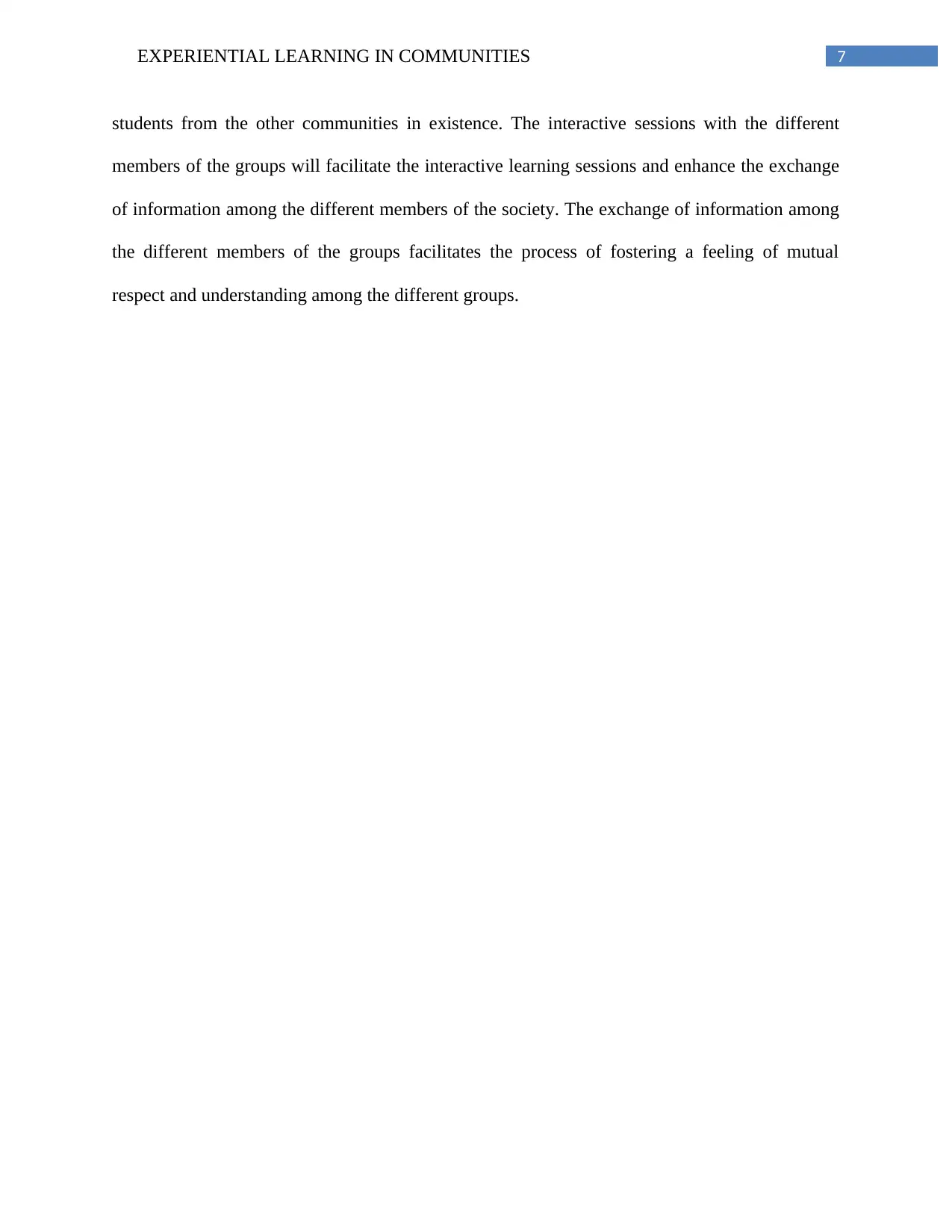
7EXPERIENTIAL LEARNING IN COMMUNITIES
students from the other communities in existence. The interactive sessions with the different
members of the groups will facilitate the interactive learning sessions and enhance the exchange
of information among the different members of the society. The exchange of information among
the different members of the groups facilitates the process of fostering a feeling of mutual
respect and understanding among the different groups.
students from the other communities in existence. The interactive sessions with the different
members of the groups will facilitate the interactive learning sessions and enhance the exchange
of information among the different members of the society. The exchange of information among
the different members of the groups facilitates the process of fostering a feeling of mutual
respect and understanding among the different groups.
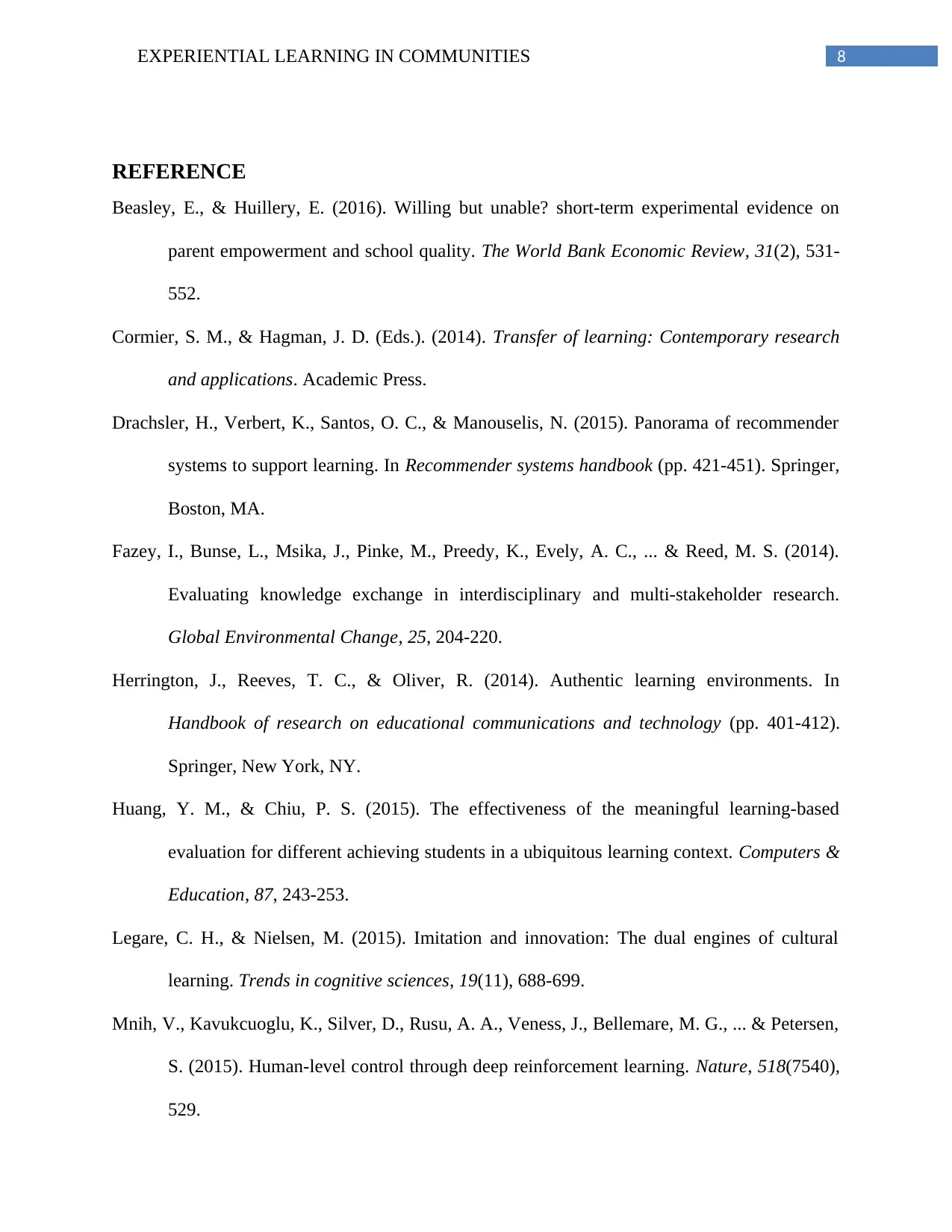
8EXPERIENTIAL LEARNING IN COMMUNITIES
REFERENCE
Beasley, E., & Huillery, E. (2016). Willing but unable? short-term experimental evidence on
parent empowerment and school quality. The World Bank Economic Review, 31(2), 531-
552.
Cormier, S. M., & Hagman, J. D. (Eds.). (2014). Transfer of learning: Contemporary research
and applications. Academic Press.
Drachsler, H., Verbert, K., Santos, O. C., & Manouselis, N. (2015). Panorama of recommender
systems to support learning. In Recommender systems handbook (pp. 421-451). Springer,
Boston, MA.
Fazey, I., Bunse, L., Msika, J., Pinke, M., Preedy, K., Evely, A. C., ... & Reed, M. S. (2014).
Evaluating knowledge exchange in interdisciplinary and multi-stakeholder research.
Global Environmental Change, 25, 204-220.
Herrington, J., Reeves, T. C., & Oliver, R. (2014). Authentic learning environments. In
Handbook of research on educational communications and technology (pp. 401-412).
Springer, New York, NY.
Huang, Y. M., & Chiu, P. S. (2015). The effectiveness of the meaningful learning-based
evaluation for different achieving students in a ubiquitous learning context. Computers &
Education, 87, 243-253.
Legare, C. H., & Nielsen, M. (2015). Imitation and innovation: The dual engines of cultural
learning. Trends in cognitive sciences, 19(11), 688-699.
Mnih, V., Kavukcuoglu, K., Silver, D., Rusu, A. A., Veness, J., Bellemare, M. G., ... & Petersen,
S. (2015). Human-level control through deep reinforcement learning. Nature, 518(7540),
529.
REFERENCE
Beasley, E., & Huillery, E. (2016). Willing but unable? short-term experimental evidence on
parent empowerment and school quality. The World Bank Economic Review, 31(2), 531-
552.
Cormier, S. M., & Hagman, J. D. (Eds.). (2014). Transfer of learning: Contemporary research
and applications. Academic Press.
Drachsler, H., Verbert, K., Santos, O. C., & Manouselis, N. (2015). Panorama of recommender
systems to support learning. In Recommender systems handbook (pp. 421-451). Springer,
Boston, MA.
Fazey, I., Bunse, L., Msika, J., Pinke, M., Preedy, K., Evely, A. C., ... & Reed, M. S. (2014).
Evaluating knowledge exchange in interdisciplinary and multi-stakeholder research.
Global Environmental Change, 25, 204-220.
Herrington, J., Reeves, T. C., & Oliver, R. (2014). Authentic learning environments. In
Handbook of research on educational communications and technology (pp. 401-412).
Springer, New York, NY.
Huang, Y. M., & Chiu, P. S. (2015). The effectiveness of the meaningful learning-based
evaluation for different achieving students in a ubiquitous learning context. Computers &
Education, 87, 243-253.
Legare, C. H., & Nielsen, M. (2015). Imitation and innovation: The dual engines of cultural
learning. Trends in cognitive sciences, 19(11), 688-699.
Mnih, V., Kavukcuoglu, K., Silver, D., Rusu, A. A., Veness, J., Bellemare, M. G., ... & Petersen,
S. (2015). Human-level control through deep reinforcement learning. Nature, 518(7540),
529.
⊘ This is a preview!⊘
Do you want full access?
Subscribe today to unlock all pages.

Trusted by 1+ million students worldwide
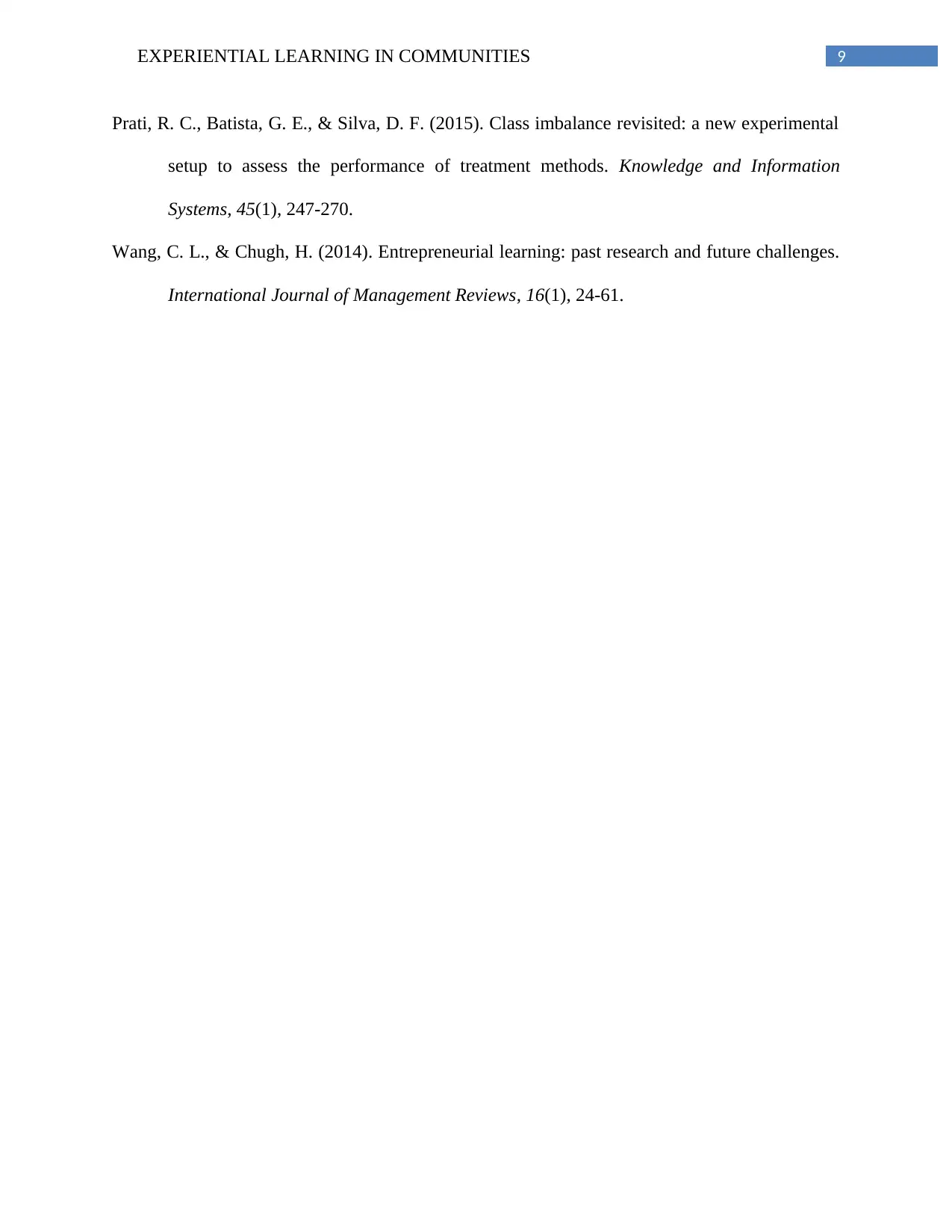
9EXPERIENTIAL LEARNING IN COMMUNITIES
Prati, R. C., Batista, G. E., & Silva, D. F. (2015). Class imbalance revisited: a new experimental
setup to assess the performance of treatment methods. Knowledge and Information
Systems, 45(1), 247-270.
Wang, C. L., & Chugh, H. (2014). Entrepreneurial learning: past research and future challenges.
International Journal of Management Reviews, 16(1), 24-61.
Prati, R. C., Batista, G. E., & Silva, D. F. (2015). Class imbalance revisited: a new experimental
setup to assess the performance of treatment methods. Knowledge and Information
Systems, 45(1), 247-270.
Wang, C. L., & Chugh, H. (2014). Entrepreneurial learning: past research and future challenges.
International Journal of Management Reviews, 16(1), 24-61.
1 out of 10
Related Documents
Your All-in-One AI-Powered Toolkit for Academic Success.
+13062052269
info@desklib.com
Available 24*7 on WhatsApp / Email
![[object Object]](/_next/static/media/star-bottom.7253800d.svg)
Unlock your academic potential
Copyright © 2020–2025 A2Z Services. All Rights Reserved. Developed and managed by ZUCOL.




